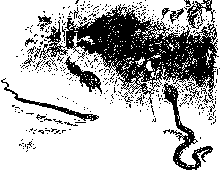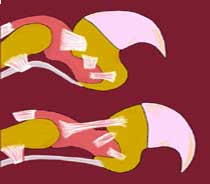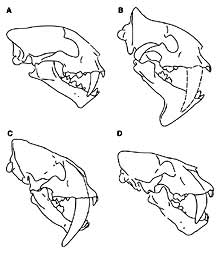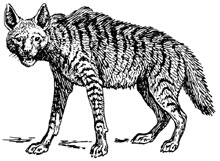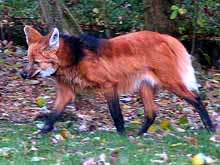 |


Reunited, and it feels so good. |


July 21, 2008
As a certified cat person, I just had to sneak the felines in there, even though it is the dog lineage that is celebrated in this month’s cover and featured story, How Dogs Came to Run the World by Xiaoming Wang and Richard H. Tedford, which I got to spend several blissful days immersed in. I'm not one of those cat people who disdains dogs, far from it—I just regard a backyard as a prerequisite, and I haven’t got one—but even someone who loves both dogs and cats will readily admit how profoundly different they are. It turns out that this difference, enshrined in folklore alongside “night and day” and “oil and water,” is correctly observed and objectively profound. To be as precise as we can, it goes back more than forty million years.
Yogi Berra famously said “When you come to a fork in the road, take it,” and that’s what the Carnivora did quite early in their evolution: some time after the appearance of the distinguishing pair of meat-shearing teeth called carnassials, the distant, tree-climbing ancestors of the cats and the dogs went their separate ways. So fundamental was this split that systematists still divide the carnivoran order into two, defined by some as the suborders Caniformia and Feliformia and by others as the superfamilies Canoidea and Feloidea. On the doggy side of the ledger are not only wolves, foxes, and dogs, but also bears, weasels and their kin (including the otter and badger), raccoons, skunks, and seals (both eared or “walking” seals and “true” seals). On the catty side, felines are related to hyenas, mongooses, and civets.
When I first learned about this split, I liked to imagine I could see (super)family resemblances in behavior: ferrets couldn’t be less like dogs, yet they invite play in just the same way, crouching down on springy front legs, something no self-respecting cat would ever do. And Rudyard Kipling’s description of how the mongoose Rikki-Tikki-Tavi kills a snake (a krait, no less) is very like the way I’ve seen a cat kill a squirrel, or for that matter the way my young Siamese, Rain, pounces on a finger wiggled under a blanket: leaping in an arc and coming down from above, with the aim of surprise plus safety—and a fatal bite to the back of the neck.
This might be the place to introduce a lucid little tutorial I found on the modern way of classifying life forms: cladistics. (I’ve been thinking about listing perennially useful sites like this one, which have saved my bacon with a basic grasp of current scientific concepts, in a permanent sidebar to this blog—a sort of emergency intellectual first-aid kit.) Modern systematists, I learned, use a combination of structural comparison (including fossils) and genomic analysis to figure out how closely related various life forms are—that is, how long ago they diverged from a common ancestor—and how to draw family trees of life with ever-increasing accuracy. (An excellent example of this two-pronged approach, as applied to us and our closest relatives, is the companion book to the new permanent exhibit at the AMNH, Human Origins: What Bones and Genomes Tell Us about Ourselves, by Rob DeSalle and Ian Tattersall, reviewed in the April 2008 issue.) When you read about the still-disputed classification of carnivorans and their extinct relatives and ancestors, you’ll see a lot of talk about features of the teeth, jaw, and skull, particularly the auditory bulla, the bony chamber of the middle ear. This structure is enlarged in predators that need an acute sense of hearing as part of their hunting arsenal, but it takes a distinctly different shape in feliforms and caniforms.
Most cats and catlike creatures have retractable rapier claws and hunt by stealth and sudden ambush. You’d never guess from looking at it that the rather doglike hyena, which hunts in hierarchical packs and has blunt-nailed paws and bone-crushing jaws, is far more closely related to the cats—unless you looked at its auditory bulla, which is divided into two by a septum like a cat’s, not single-chambered like a dog’s. (In cladistics this is called a synapomorphy, Greek for “dead giveaway”—well, anyway, for a shared anatomical trait that is diagnostic of kinship.) And the bulla is only one of a number of hidden clues to the hyena’s true genetic allegiance, which is unmistakably “feloid.”
We no longer think that a whale is a fish because it lives in the sea, as the Book of Jonah would have it, and as a New York State court ruled in an 1818 dispute over the regulatory status of three casks of whale oil (the subject of another book, Trying Leviathan, which we reviewed in March 2008). In fact, gene sequencing has revealed, a whale’s closest non-cetacean cousin is the hippopotamus. But we can still be fooled by the tricks of convergent evolution, which superimposes a whole different pattern—that of similar adaptations to similar environmental challenges and chances—on top of the genetic family tree, and often obscures it.
And here I stumbled on the mind-blowing work of Meehan and Martin—not a comedy team, but a pair of convergent-evolution connoisseurs. The first paper of theirs I found, the title of which only begins “Extinction and re-evolution of similar adaptive types (ecomorphs),” made an arresting suggestion: that the hyena was an Old World “dog ecomorph.” That is, in the absence of canids—then busy evolving exclusively in North America—hyenas arose in the catlike lineage to fill much the same predatory niche as canids, and therefore to develop a similar form and behavior.
This 2002 paper (PDF) seems to be available only for pay (I have it, so I guess I must have paid for it—what got into me?), but a 2004 paper by the same authors, “Extinction may not be forever,” can be downloaded here (PDF) for the minor annoyance of registration. From the second one:
The power of natural selection to override genealogy to create similar morphologies (even among distantly related organisms) supports classical Darwinian evolution. . . . Natural selection produces suites of coordinated similarity resulting from shared activities, rather than shared phylogeny. If the shared activity is an integral part of an “ecological occupation,” it may predict other similarities related to that occupation. . . . It is this ability of ecological position to predict anatomy independent of phylogeny that is the basis of the ecomorph concept . . . Convergent organisms have been called ecomorphs (ecological morphotypes; Williams 1972). . . . Convergent forms evolve independently in separated but similar ecologies, demanding only that adequate predecessors for the morphological type be present. Similar ecomorphs generally do not evolve in the same region at the same time, but require either geographic or temporal separation.
Meehan and Martin say the fossil record shows that similar forms have died out and evolved again and again in response to cycles of climate and vegetation. (How like the cyclical epochs of ancient mythologies this is!) For example, recurring fossil variations on the saber-tooth cat theme, derived from rather different antecedents, have been found in geological strata widely separated in time but similar in the conditions that laid them down. If you read Wang and Tedford’s article, you’ll see the same thing happening as the three lineages of canids, which coexisted but took turns diversifying and dominating, each evolved from a “fox ecomorph” preying on small mammals to a “wolf ecomorph” that hunted large, fast ungulates in cooperative, “cursorial” (running) packs—an adaptation to drying climate and the replacement of forest by open grassland. The two extinct lineages ultimately evolved heavy, bone-crushing scavenger forms before yielding the stage to the Caninae, which fill most of those niches today (though the bone-crushing dire wolf sleeps in the tar at La Brea)—as well as a new niche, perhaps “only” 100,000 years old, but rooted in the two-million-year-old emergence of another hunter of the savanna, what might be called a cursorial primate: Homo.
Coming Soon: Dog Days, II: Wild speculations on the coevolution of Homo sapiens and Canis familiaris.
Extras:
- Canids: Foxes Wolves, Jackals, and Dogs (PDF). An illustrated, downloadable 2004 book (over 440 pages) from the IUCN/SSC Canid Specialist Group, surveying all the living canid species, their ecology and conservation status. A must-have—everything you ever wanted to know about the larger dog family, and more—for free!
- The sex life of the spotted hyena: There’s nothing else like it on earth; human transsexualism pales by comparison. You too will blanch at the thought of giving birth through a pseudopenis.
- A soupçon of heresy: If genetic variation is really random, why and how does nature, which supposedly has no memory, keep recreating much the same forms after they’ve died out, or in unrelated lineages? According to the theory of natural selection, the logic of a particular ecosystem constrains variation; a given niche in a given climate, terrain, and coevolving biota acts like a “mold” that casts similar shapes from whatever genetic stuff is poured into it. That’s why Meehan and Martin say that the fossil evidence for recurring ecomorphs “supports classical Darwinian evolution.”

But the evidence could also support Rupert Sheldrake’s theory of morphic resonance, which proposes that nature does have a memory—that once a form has evolved for the first time, it becomes an “attractor” or a “habit of nature” which makes it more likely that evolution will resort to that form again. Sheldrake’s theory, most thoroughly explained in his book The Presence of the Past, is officially considered a woo-woo no-no because it posits action at a distance: nature’s “memory” inheres in fields of an unknown nature, which he calls “morphogenetic fields.” (Biology just hasn’t gotten as weird as physics yet; electrons at opposite ends of the universe may take a spin together, but biomolecules have to bump.)
Sadly, Sheldrake has pretty much given up on the scientific community and seemingly turned into the eccentric they accused him of being: he now spends his time trying to persuade the public of action at a distance by pointing to homely, uncanny phenomena such as . . . dogs that know when their owners are coming home!
(Or lions that know when their former owners are flying to Africa for a reunion.)
- Cats and chromosomes: If you’re really in the mood for some mental gymnastics, reread Olivia Judson’s June Life Zone on chromosome number and evolution, and then look here, here, and here for a few hints about how chromosome fissions and fusions have played a part in carnivoran evolution. (These would definitely be “heavies,” except they’re only short abstracts.)


(Annie Gottlieb) |
Comments (add yours!)

Return to July-August home
|


